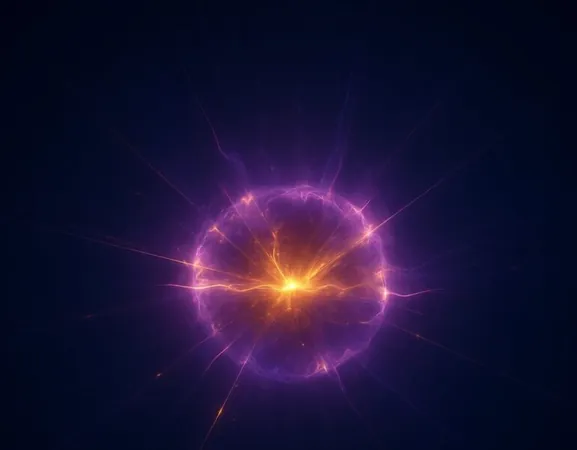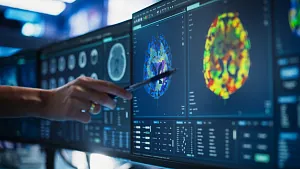
Cosmic Revelations: Quantum Breakthroughs and Life’s Building Blocks
2025-08-08
Author: Rajesh
This week has been a thrilling ride in the realms of research and development. From the unveiling of GPT-5, a groundbreaking AI model, to the discovery of crucial life ingredients in the cosmos, science is pushing boundaries like never before. Moreover, groundbreaking health treatments are emerging to battle devastating diseases, while quantum innovations are reshaping our comprehension of reality.
Quantum Computing: New Developments Unleashed
Columbia Engineering scientists have made a significant stride in quantum computing with their introduction of HyperQ. This system allows multiple users to share a single quantum computer simultaneously through isolated quantum virtual machines (qVMs).
Thanks to HyperQ, user wait times have been slashed by an astonishing 40 times, turning project timelines from days into mere hours. This advancement addresses a major limitation of many quantum computers, which traditionally support single-user applications due to qubit interconnectivity.
Unveiling Quantum Liquid Crystals
In a stunning discovery, researchers from Rutgers University identified a new quantum state dubbed "quantum liquid crystal" by combining Weyl semimetals with spin ice materials under extreme conditions. This breakthrough noted the first observation of electronic anisotropy at a heterostructure interface, opening doors to ultra-sensitive quantum sensors.
Revolutionary Research in Material Science
In another eye-opening study, scientists have managed to superheat gold to an incredible 19,000 Kelvin using ultrafast laser pulses while keeping it solid. This groundbreaking work lays the foundation for better understanding unusual states of matter, like plasma, which could revolutionize how we measure temperature in dense matter.
AI Innovations Abound
The AI landscape is buzzing with activity, as OpenAI and Anthropic have unveiled a series of new models. OpenAI introduced gpt-oss-120b and gpt-oss-20b, advancing their open-weight release strategy designed to democratize access to advanced AI capabilities. Meanwhile, Anthropic released the latest update of Claude Opus 4.1, showcasing its prowess in AI-assisted coding.
Célestial Discoveries: Organic Molecules in Space
Astoundingly, the ALMA telescope has detected 17 complex organic molecules in the protoplanetary disk surrounding the star V883 Orionis, just 1,305 light-years away. This groundbreaking finding not only affirms the presence of life's building blocks in the cosmos but suggests they may be common throughout the universe.
NASA’s Ambitious Lunar Plans
In an exciting vision for the future, NASA’s Acting Administrator has highlighted plans for establishing nuclear power infrastructure on the Moon. This capability is envisioned as a cornerstone for sustaining human life on the lunar surface, aligning with long-term goals of lunar habitation.
Innovations in Medicine and Biotechnology
In medical breakthroughs, the FDA has granted accelerated approval for Jazz Pharmaceuticals' Modeyso, a groundbreaking treatment for a rare and aggressive brain cancer affecting children. With a clinical response rate of 22%, this new drug offers hope for those battling this devastating illness.
Additionally, researchers have created a new vagus nerve-stimulating implant that promises to alleviate symptoms of rheumatoid arthritis without relying on drugs, showcasing the potential of bioelectronic medicine.
Groundbreaking Desalination Technology Emerges
MIT has revealed a revolutionary desalination system capable of producing freshwater cheaper than municipal tap water. This innovation holds promise for addressing global water scarcity challenges, offering hope for billions around the world.
Synthetic Biology Advances: New Possibilities
In synthetic biology, scientists have engineered E. coli bacteria using a 57-codon genetic code instead of the standard 64, marking a significant achievement in our ability to manipulate biological systems. This breakthrough paves the way for the creation of organisms resistant to viral infections and capable of producing unique proteins for various applications.
As these extraordinary advancements continue to unfold, the scientific community stands on the brink of yet another remarkable era of discovery and innovation.



 Brasil (PT)
Brasil (PT)
 Canada (EN)
Canada (EN)
 Chile (ES)
Chile (ES)
 Česko (CS)
Česko (CS)
 대한민국 (KO)
대한민국 (KO)
 España (ES)
España (ES)
 France (FR)
France (FR)
 Hong Kong (EN)
Hong Kong (EN)
 Italia (IT)
Italia (IT)
 日本 (JA)
日本 (JA)
 Magyarország (HU)
Magyarország (HU)
 Norge (NO)
Norge (NO)
 Polska (PL)
Polska (PL)
 Schweiz (DE)
Schweiz (DE)
 Singapore (EN)
Singapore (EN)
 Sverige (SV)
Sverige (SV)
 Suomi (FI)
Suomi (FI)
 Türkiye (TR)
Türkiye (TR)
 الإمارات العربية المتحدة (AR)
الإمارات العربية المتحدة (AR)